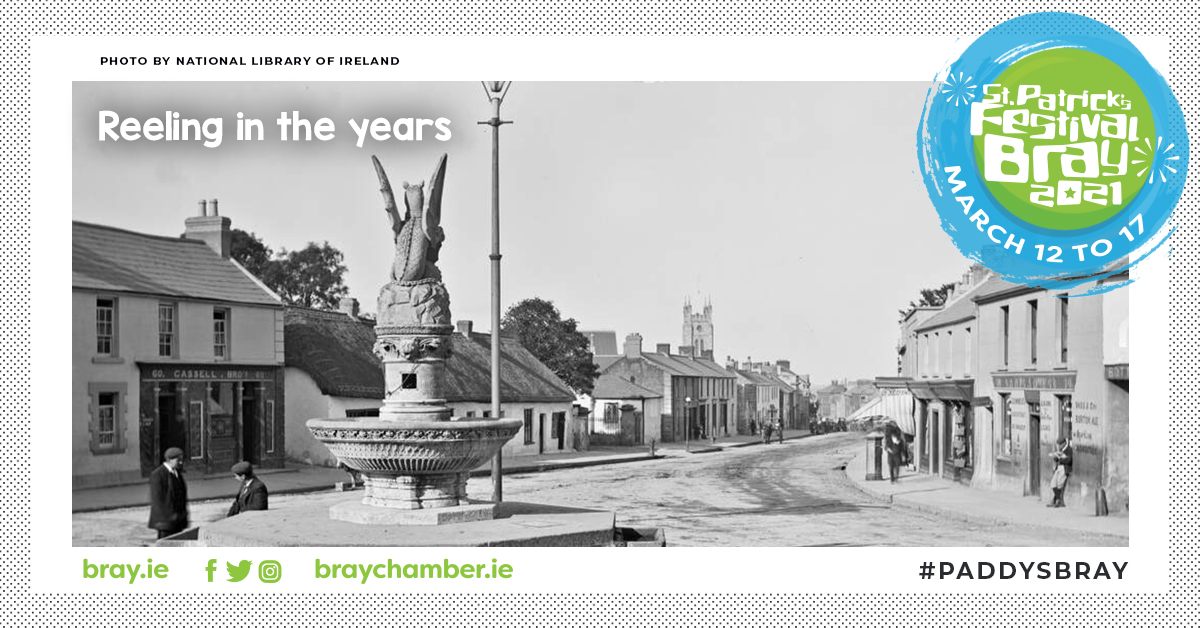Below are some historical St. Patrick’s Day Bray facts curated by Brian White from Bray Cualann Historical Society:
- According to Jackman Conmey who wrote an article in a journal called ‘The Shamrock’ on July, 28th 1877, “The earliest notice I have seen of Bray is in a school history of Ireland, where St. Patrick is said to have landed at the mouth of Bray River AD 432. Thence went North as far as Innis Patrick an island near Skerries”. This is backed up by a map of Leinster by John Speed in 1610 where the area south of Bray Head is called St Patrick’s Land.
- In Bray, St. Patrick’s National School on the Vevay Road was a hospital in WW1 and it was funded by local collections and a major fundraising drive in America called the Shamrock Fund.
- The Statue of the Wyvern in front of Bray’s Town Hall is decorated with seashells and shamrocks. The Town Hall was used as a recruiting office in WW1 and would have displayed a poster that included St. Patrick.
- In the Holy Redeemer Church, there is a statue of St. Patrick. On St Patrick’s Day 1918 the police stopped the Bray Pipe Band marching to the Church because they did not hold a permit to play music on the street.
- The Bray Royal Cinema on the Quinsboro Road was opened on St. Patrick’s Day 1935, on the same day Solus Electric Lamps opened their factory at Corke Abbey.
- On Dargan Street in Little Bray, there is a lamp standard with Shamrock motifs (the only lamp standard of this design in Bray).
- Doctor surgery’s and Pharmacies’ display the medical symbol of a sword and a snake. The first two houses in Brighton Terrace display this medical symbol. St. Patrick was supposed to have banished all poisonous snakes from Ireland. In 1900 the gardener’s son at Hollybrook House, Bray discovered two poisonous snakes in a consignment of plants. Two weeks later another snake was discovered on Mr Thompson’s farm in Delgany.
- Following WW2 the Irish Red Cross organised to bring refugees to Ireland and they were housed in the old Glencree Reformatory and this operation was called “Operation Shamrock”.
- More than 500 buildings and structures across the world light up green for St Patrick’s’s day as part of Tourism Ireland’s “Global Greening” initiative. This year (2021) throughout St. Patrick’s week, iconic Bray buildings will go green to mark our National Day. Read more here. Read more about #GlobalGreening initiative here.
Here are some more things you didn’t know about St. Patrick’s Day
- St. Patrick’s name wasn’t actually Patrick. His real name was actually Maewyn Succat.
- St. Patrick wasn’t Irish. Although Patrick is the patron saint of Ireland, he was actually born in Wales.
- St. Patrick’s association with green is just a couple of centuries old. For over 1,000 years St. Patrick’s hue was blue.
- Ireland’s first St Patrick’s Parade took place in Dublin in 1931. New York lays claim to the world’s first planned parade in 1762, but Boston claims an impromptu one for 1737.
- St. Patrick’s Day did not become a public holiday here until 1903 when the Westminster Parliament passed a bill introduced by the Irish MP James O’Mara.
- For decades, all adverts were banned on St. Patrick’s Day, which was devoted to traditional music, religious services and uplifting back-from-the-future speeches such as Taoiseach De Valera’s 1943 pep-talk looking forward to returning to a Brigadoon world of “happy maidens dancing at the crossroads”.
- In a Simpson’s Paddy’s Day special, newsman Kent Brockman calls it “the day when everyone is Irish”.
- According to a US Census, there are more Irish people in America than there are in Ireland. In recent years, more than 34 million Americans claimed Irish ancestry.
- Did you know that bowl of shamrock the Taoiseach traditionally gives the US President is destroyed almost immediately by the US Secret Service? For security reasons, you’re not allowed to give food or floral gift to the US President.
- St. Patrick’s Day isn’t just a national holiday in Ireland. It’s also a national holiday on the island of Montserrat in the Caribbean, a tiny island with around 4,000 inhabitants which became home to a large number of Irish emigrants in the 17th century. Montserrat is holding an entire week of celebrations, including a Patrick’s Day dinner, a calypso competition and a church service.
